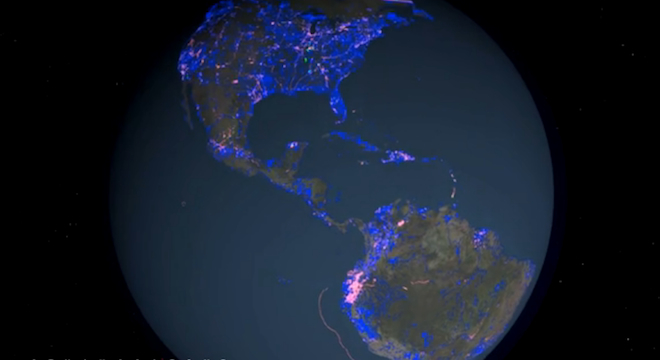OpenStreetMap is on a roll: Over eight years after it was founded by a single computer engineer in the UK, the free digital map assembled by volunteers around the globe crossed 1 million registered users as of early this week, the start of 2013.
However, as OpenStreetMap’s power users were quick to note, only about one third of those registered accounts — about 300,000 users worldwide, including a particularly active bunch on the country’s home continent Europe — end up contributing any edits to the map at all.
That’s still an incredible growth, especially considering that nearly half a million new signups occurred in 2012 alone.
See an OpenStreetMap user growth chart from the OSM Wiki here.
Perhaps that’s why Simon Poole, the recently elected chairman of the project’s organizing body, the nonprofit OpenStreeMap Foundation, is so confident that OpenStreetMap has what it takes to surpass Google Maps in quality in the U.S. in the coming years.
“I would expect OpenStreetMap in the U.S. to be comparable to Google in a period of one to two years,” Poole told TPM in a telephone interview from his home in Switzerland.
Check out the following video supercut of all the edits made to OpenStreetMap over the course of 2012, created by mapper Derick Rethans:
Throughout last year, a number of major tech companies and organizations flocked to OpenStreetMap to use some of its global map data over Google’s. Among them were Foursquare, Wikipedia, Craigslist and even Apple.
But the motivating factor for those tech giants wasn’t the fact that OpenStreetMap has better global coverage per se — although it is more detailed in some areas. Rather, the catalyst seemed to be Google’s decision at the start of 2012 to begin charging for heavy use of Google Maps data.
While some in OpenStreetMap’s community welcomed the use of their data by tech companies as a validation of its accuracy and importance, many others are wary of the growing commercial usage of the service, especially after OpenStreetMap’s founder Steve Coast announced a commercial users only conference last October.
“That has always been a large concern,” Poole told TPM. “Mappers put in an awful lot of time and work into collecting data and keeping it up to date, so there are concerns of going in direction where commercial usage or any kind of use would be possible without giving something back.”
OpenStreetMap’s own licensing terms specifically state that those private companies that take the free, crowdsourced data from OpenStreetMap and use it to improve their own products — or “derivative databases” — need to turn around and make any resulting new, improved data free to use as well. But for-profit companies clearly aren’t about to turn over proprietary technology for free, creating something of an impasse.
While Poole said he supports more commercial use and “personally would be in favor of much more permissive license,” allowing for greater for-profit use of OpenStreetMap’s data, he doesn’t think “there’s going to move away from ‘share alike’ in the short term.”
“I don’t see another license change in the next year or two,” Poole said.
That’s partially because OpenStreetMap already spent the last several years shifting away from an older data usage license (Creative Commons By Share Alike 2.0) to a newer one more specific to the kind of data its contributors collect and share (Open Database License).
Poole, who was a leader in that license changeover effort, called it a “very tenuous, strenuous thing,” as it involved obtaining consent to switch from every single OpenStreetMap contributor, or deleting the data of those who did not consent to the new license.
“It brought the organization nearly to its knees,” Poole told TPM.
But now that Poole and others involved in the license changeover successfully shepherded it through, leading in part to Poole’s election to the OpenStreetMap chairmanship last September — the first such leader to take over from the project’s founder, Steve Coast — Poole is focused on the future.
“The main theme for 2013 is moving away from the introspective mode we’ve been in over the last 3 years, with the license change being the dominating theme and essentially stalling any other development, and looking more forward and outward,” Poole explained.
Part of that new direction is already occurring thanks to an American commercial entity’s involvement in OpenStreetMap: Washintgon, D.C.-based startup Mapbox, using a half-million dollar grant from the Knight Foundation, is working to improve OpenStreetMap’s editor user interface, to make it easier and more appealing for the next million users.
Poole agrees that this is a major requirement for the project to continue its phenomenal growth.
“About three years ago, I took a look at OpenStreetMap and initially thought: ‘this is too complicated,'” Poole said.
But members of OpenStreetMap’s active editor community are pursuing flashier updates as well, such as building 3D maps comparable to Google’s and indoor maps, which Google has also been rapidly pursuing.
“We can occupy ourselves for the next fifty years if we go down those next two routes,” Poole said.
As for who may switch to OpenStreetMap in 2013 — sources with knowledge have indicated that even Facebook is considering a switch from Microsoft Bing Maps to OpenStreetMap — Poole wasn’t ready to make any predictions.
“It’s very unclear in the long term how these map wars will play out,” Poole said. “Naturally Facebook switching to OSM would be an order to magnitude larger event [than previous companies], but I don’t foresee problems from a contributor point of view.”
Correction: This article originally stated OpenStreetMap’s licensing terms required companies to make products built using OSM data free to use, when it fact, the license does not require this, but requires any “derivative databases” to be distributed under the same license. We have corrected the error in copy and regret it.






